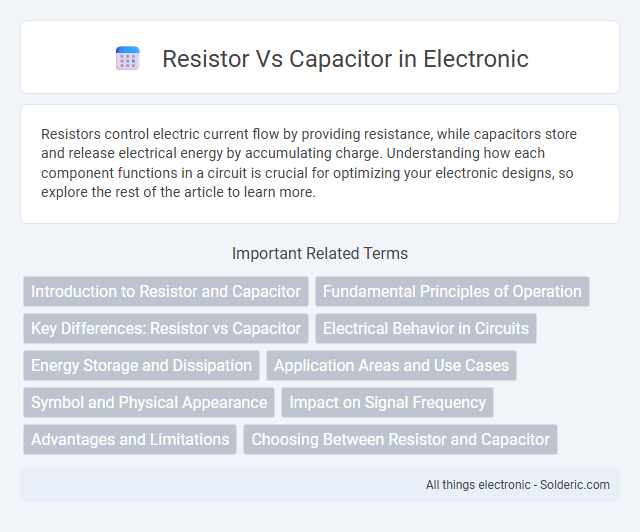Resistors control electric current flow by providing resistance, while capacitors store and release electrical energy by accumulating charge. Understanding how each component functions in a circuit is crucial for optimizing your electronic designs, so explore the rest of the article to learn more.
Comparison Table
| Feature | Resistor | Capacitor |
|---|---|---|
| Function | Limits current flow and drops voltage | Stores and releases electrical energy |
| Unit | Ohm (O) | Farad (F) |
| Symbol | --O-- | || |
| Type of Component | Passive | Passive |
| Energy Storage | No | Yes |
| Frequency Response | Constant impedance | Impedance decreases with frequency |
| Applications | Current limiting, voltage division, biasing | Filtering, signal coupling, timing circuits |
| Power Dissipation | Yes, converts energy to heat | No significant power loss |
Introduction to Resistor and Capacitor
Resistors regulate electrical current by providing opposition, measured in ohms, and are essential for controlling voltage and current levels in circuits. Capacitors store and release electrical energy through an electric field, characterized by capacitance in farads, and play a key role in filtering, timing, and energy storage. Understanding the differences between your resistor's resistance and your capacitor's capacitance enables effective circuit design and optimization.
Fundamental Principles of Operation
Resistors operate by opposing the flow of electric current through a material, converting electrical energy into heat based on Ohm's law (V = IR). Capacitors store and release electrical energy by accumulating charge on conductive plates separated by an insulating dielectric, characterized by capacitance (C) measured in farads. The fundamental difference lies in resistors dissipating energy continuously, while capacitors temporarily store energy and release it, influencing circuit behavior in time-dependent ways.
Key Differences: Resistor vs Capacitor
Resistors control electrical current by providing a fixed opposition measured in ohms, converting electrical energy into heat. Capacitors store and release electrical energy by accumulating charge across their plates, measured in farads, influencing voltage levels in circuits. You can distinguish them by their roles: resistors manage current flow continuously, while capacitors temporarily store energy and affect signal timing or filtering.
Electrical Behavior in Circuits
Resistors oppose electric current by converting electrical energy into heat, maintaining a constant resistance regardless of frequency. Capacitors store and release electrical energy by accumulating charge on their plates, causing impedance to vary inversely with frequency. In AC circuits, resistors dissipate real power while capacitors influence reactive power, shaping voltage and current phase relationships.
Energy Storage and Dissipation
Resistors dissipate energy by converting electrical energy into heat, which results in continuous energy loss during current flow. Capacitors store energy electrostatically in an electric field, releasing it without dissipation when the circuit requires it. Understanding how your circuit manages energy storage in capacitors versus energy dissipation in resistors is critical for optimizing performance and efficiency.
Application Areas and Use Cases
Resistors are essential in controlling current flow, voltage division, and signal conditioning across electronics like power supplies, audio devices, and digital circuits. Capacitors excel in energy storage, filtering, and frequency tuning, making them crucial for applications such as power smoothing, timing circuits, and signal coupling in communication devices. Understanding your project's requirements helps determine whether a resistor's linear resistance or a capacitor's reactive properties best suit your design needs.
Symbol and Physical Appearance
A resistor symbol consists of a zigzag line or a rectangle, representing its function of limiting electric current. Physically, resistors are small cylindrical components with colored bands indicating resistance values. Capacitor symbols feature two parallel lines, often with one curved line for polarized capacitors, while actual capacitors appear as two metal plates separated by an insulating material, typically encased in a cylindrical or rectangular body.
Impact on Signal Frequency
Resistors maintain a constant opposition to current flow regardless of signal frequency, causing a steady voltage drop proportional to current. Capacitors, however, exhibit frequency-dependent reactance, decreasing impedance as signal frequency increases, thus allowing higher-frequency signals to pass more easily. This frequency-sensitive behavior of capacitors makes them essential in filtering, tuning circuits, and signal conditioning applications.
Advantages and Limitations
Resistors offer precise control over current flow with predictable and stable resistance values, making them essential for voltage regulation and current limiting in circuits. Capacitors excel in storing and releasing energy quickly, enabling filtering, energy smoothing, and signal coupling, but they have limitations such as leakage current and limited energy capacity. Understanding the advantages and limitations of resistors and capacitors helps you design efficient and reliable electronic systems tailored to your needs.
Choosing Between Resistor and Capacitor
Choosing between a resistor and a capacitor depends on the specific function in the circuit, with resistors primarily controlling current flow and capacitors storing and releasing electrical energy. Resistors provide consistent resistance, ideal for voltage division and current limiting, while capacitors are essential for filtering, timing, and energy storage applications. Understanding the required behavior, such as steady-state versus transient response, guides the optimal choice between resistor and capacitor components.
resistor vs capacitor Infographic

 solderic.com
solderic.com